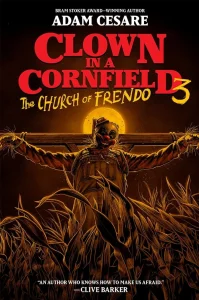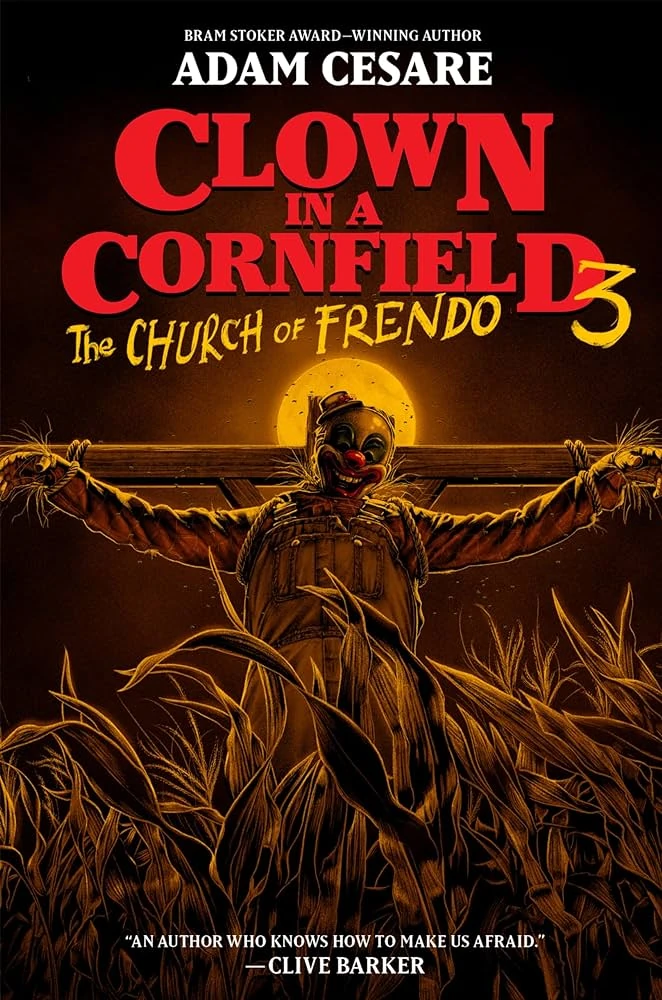This Conclusion Doesn’t Do the Series Justice
The third novel of Adam Cesare’s Clown in a Cornfield series was published end of August. I really like the series and once again listened to the audio book narrated by Jesse Vilinsky. However, the conclusion of the trilogy turns out to be a tough ride that also tries to get by without the beloved characters from the previous titles.
Spoiler warning: This review reveals the content of the first two novels.

Twice has Quinn Maybrook survived attacks by clown fanatics in the small town Kettle Springs. Disguised as Frendo the Clown, these people have repeatedly hunted young people like her. Even now, long after the original mastermind behind the attacks is dead, Frendo’s followers will not rest. But Quinn has had it with being a victim. She decides to hunt down the remaining killers proactively.
Clown in a Cornfield not only follows the rules of the slasher film, but also infuses them with fresh blood. This also applies to the respective sequels: in the first volume, Quinn becomes the heroic final girl, similar to Laurie Strode in Halloween (1978). In the second novel, the killer seems to be buried at first, only to reappear and force Quinn back into the role of the defensive, helpless teenager. In the final entry of the trilogy, she finally gives becomes a vigilante and thus the very thing she despises. Despite this fidelity to the slasher genre, the novels are by no means predictable or boring. This is precisely why the series is so close to my heart.
Clown in a Cornfield Without Strong Characters?
Above all, the strength of the novels lies in the likeable characters that Cesare creates. The author is not afraid to let these characters die. Unlike in many generic slasher films, we are thereby reminded that this is still a story about people with their own backgrounds, desires and dreams. It is these three-dimensional people who are for no reason killed by masked killers. In the first two volumes, Quinn, Rust and Cole are established as heroic main characters who rise above their own weaknesses and never lose cohesion in the process.
These beloved characters are thrown overboard in the third novel of the series. Rust and Cole, who fall in love in the first volume, have bought a country house and now live there together. They play no relevant part in The Church of Frendo. Quinn’s father, who is still the mayor of Kettle Springs, only makes a brief appearance as well. Instead, the focus is entirely on Quinn, who no longer bears any resemblance to the protagonist of the first two novels. She has developed from a person who clings to her fellow human beings and fights for them into a lonely vigilante. It is repeatedly claimed that her vendetta against the Frendo fanatics is motivated by the desire to protect her loved ones. But we see very little of this. Quinn only tries to call her father twice. She doesn’t try to contact Rust and Cole, nor anybody else. Only with Johnny D., whom she meets on her journey through the USA, does she build up a kind of relationship. Instead of sticking to established relationships, Clown in a Cornfield 3 prefers to focus on new characters. However, this reduced cast of characters not only makes Quinn seem detached, but above all jaded.
An Aimless Journey Through the USA
The fact that the plot is not confined to a small, defined setting such as the mid western town Kettle Springs is also troublesome. Chapter by chapter, Quinn travels across the USA. She plans exactly how often she has to change cars, where she can cross state borders most inconspicuously, and how she can gain untraceable internet access for her necessary research. In many respects, The Church of Frendo bears parallels to the road movie. This certainly has potential, but is not really implemented in an entertaining way. Quinn’s journey seems aim- and anchorless and we get no sense of either the elapsing time nor the changing landscape. However, these are all aspects that would be extremely important for a lively travel narrative.
Equally aimless seems the journey and growth of Frendo’s followers. It is not entirely clear what keeps fascinating people about the clown. After all, he was originally just the mascot of a tiny, unimportant town. To explain this, every novel up has shown how people turn into killer clowns. The first volume is primarily about vigilantism and an outraged generation of parents who have no understanding of their own children’s reality of life. The second volume shows how the Frendo murders become a social media hype that is exploited by influencers. In the third volume, the small-town mascot has finally become a religious figure. But how exactly this happened and why there is a “Church of Frendo” at all is dealt with in a handful of unbelievable sentences.
It appears as if Adam Cesare didn’t feel entirely comfortable with the road movie similarities himself. To remedy that, he introduces a second narrative. Every now and then, we follow the young girl Tabitha, who lives in an Amish settlement, ominously called New Kettle Springs. The novel depicts life in this township in a much more interesting way than Quinn’s road trip.
An Unworthy Conclusion
As much as I was looking forward to being whisked away into the world of fanatical clown killers for a third time: Clown in a Cornfield 3 detracts from the series more than it adds to it. The characters I love simply no longer exist ; they’ve been thrown under the bus for the sake of the story. Equally unworthy is the handling of the iconic figure of Frendo. The leap from clown mascot to religious savior is incomprehensible and seems cheap. This is not aided by the story’s ambiguous conclusion, which – like the typical horror movie – leaves every avenue open for a sequel.
Unrelated to the novel itself, full marks once again go to audiobook narrator Jesse Vilinsky. Her performance is convincing and entertaining on all levels: individual dialects, clearly distinguishable character voices, and an exciting, fast-paced reading. It simply has it all.
Fact Sheet: Clown in a Cornfield 3
Year of Publication: 2024
Autor: Adam Cesare
Narrator: Jesse Vilinsky
Audiobook Length: 11h, 6m (To put it differently: 666 minutes!)

